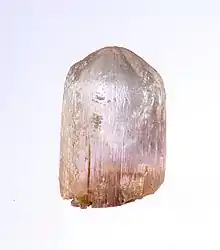| Poudretteite | |
|---|---|
 | |
| General | |
| Category | Cyclosilicate |
| Formula (repeating unit) | KNa2B3Si12O30 |
| IMA symbol | Pou[1] |
| Strunz classification | 9.CM.05 |
| Dana classification | 63.02.01a.08 |
| Crystal system | Hexagonal |
| Crystal class | Dihexagonal dipyramidal (6/mmm) H-M symbol: (6/m 2/m 2/m) |
| Space group | P6/mcc |
| Unit cell | 1,221.72 ų |
| Identification | |
| Color | Colorless, Light pink |
| Crystal habit | Roughly equant barrel-shaped prismatic crystals |
| Cleavage | None |
| Fracture | Conchoidal, splintery |
| Tenacity | Brittle |
| Mohs scale hardness | 5 |
| Luster | Vitreous (Glassy) |
| Streak | White |
| Diaphaneity | Transparent |
| Specific gravity | 2.51 |
| Density | 2.51 |
| Optical properties | Uniaxial (+) |
| Refractive index | 1.511 to 1.532 |
| Birefringence | 0.021 |
| Pleochroism | Colorless to pink |
| References | [2][3][4][5][6] |
Poudretteite is an extremely rare mineral and gemstone that was first discovered as minute crystals in Mont St. Hilaire, Quebec, Canada, during the 1960s.[6] The mineral was named for the Poudrette family because they operated a quarry in the Mont St. Hilaire area where poudretteite was originally found, and the quarry is currently owned by the United Kingdom based Salmon Mining Industries Inc. Poudretteite has a barely detectable radioactivity.[7]
References
- ↑ Warr, L.N. (2021). "IMA–CNMNC approved mineral symbols". Mineralogical Magazine. 85 (3): 291–320. Bibcode:2021MinM...85..291W. doi:10.1180/mgm.2021.43. S2CID 235729616.
- ↑ "Mineralienatlas – Fossilienatlas".
- ↑ Barthelmy, Dave. "Poudretteite Mineral Data". webmineral.com.
- ↑ "Poudretteite: Poudretteite mineral information and data". www.mindat.org.
- ↑ "Poudretteite gemstone information". www.gemdat.org.
- 1 2 "Poudretteite – The Gemology Project". gemologyproject.com.
- ↑ Multicolour – Poudretteite Archived 2013-04-12 at the Wayback Machine
This article is issued from Wikipedia. The text is licensed under Creative Commons - Attribution - Sharealike. Additional terms may apply for the media files.